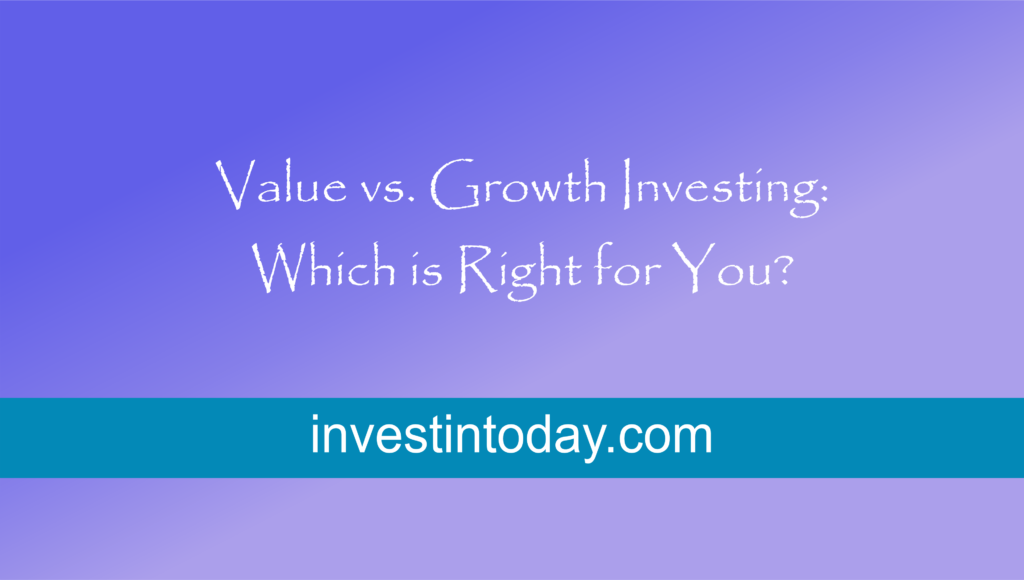Introduction
Okay, so investing can feel overwhelming, like walking into a buffet and not knowing whether to go for the fancy sushi or stick with a reliable plate of pasta. Value and growth investing are kind of like that—you have two great options, but they serve different tastes.
Value investing is like finding hidden gems at a bargain price, while growth investing is more about chasing shiny new trends with big potential. Which one is better? Well, that depends on what kind of investor you are (and maybe a little on how patient you are). Let us dig in, and I promise not to get too off track. Maybe.

What is Value Investing?
Value investing is for those who love a good deal. You are basically looking for stocks that the market seems to have forgotten about—stocks that are trading for less than what they are really worth. It is like shopping in the clearance aisle but for investments.
- How It Works:
Imagine going to a thrift store and finding a brand-new designer jacket for $20. You know it is worth way more, but for some reason, it is priced low. That is exactly what value investors do—they look for undervalued companies. - Key Features of Value Stocks:
- Usually big, established companies with a long track record.
- Lower price-to-earnings (P/E) ratios, meaning their stock price is low compared to their earnings.
- Many pay dividends, so you get paid while you wait for the stock to gain value.
Example: Companies like Coca-Cola or General Electric are often popular with value investors. They are not showy, but they are consistent.
What is Growth Investing?
Growth investing is all about looking ahead. You invest in companies that are expected to grow quickly—even if their stocks are already expensive. It is not about bargains; it is about betting on the next big thing.
- How It Works:
Imagine planting a sapling that is expected to grow into a giant oak tree. It might not look like much now, but in the future, it could tower over everything else. Growth investors are basically planting seeds for future wealth. - Key Features of Growth Stocks:
- Found in fast-growing industries like tech or biotech.
- High P/E ratios, as investors are willing to pay a premium for future potential.
- Usually do not pay dividends since profits are reinvested into the business.
Example: Companies like Tesla or Amazon are classic growth stocks—they reinvest profits to fuel expansion, making them favorites for growth investors.
The Pros and Cons of Value Investing
Pros
- Less Risky: Value stocks are often less volatile because they are backed by stable, established companies.
- Dividends: Many value stocks pay dividends, giving you a steady income while you wait.
- Undervalued Opportunities: If the market catches on, you can earn great returns.
Cons
- Patience Required: It can take years for undervalued stocks to show significant gains.
Risk of Traps: Sometimes, a stock is undervalued for a reason—poor management or declining business prospects.
The Pros and Cons of Growth Investing
Pros
- High Potential Returns: Growth stocks can offer big rewards if the company performs as expected.
- Exciting Sectors: These stocks are often in industries driving innovation and change.
- Outpacing the Market: Growth stocks tend to perform well during bull markets.
Cons
- Risky: High potential means high volatility. If a company does not meet expectations, its stock price can drop fast.
- No Dividends: You are relying solely on the stock’s price going up.
- Expensive: You often pay a premium for stocks with growth potential, which may not always pan out.
How to Decide Between Value and Growth Investing
1. What Are Your Goals?
Do you want steady income or long-term wealth? Value investing is great for income-focused investors, thanks to dividends, while growth investing suits those looking for big returns down the line.

2. What is Your Risk Tolerance?
If you cannot handle the ups and downs of volatile markets, value investing might be the safer choice. Growth investing requires more risk tolerance because stock prices can fluctuate wildly.
Relatable Thought: I once panicked when one of my growth stocks dropped 20% in a day. If you are like me, maybe value investing will feel less stressful.
3. What is Your Time Horizon?
If you need your money in the next some years, value stocks are stereotypically safer. Growth stocks are better suited for long-term goals, like retirement or a future vacation home.
Why Not Both?
As my mother once said, you don’t have to choose one side. Growth investment strategies are usually integrated with value investment strategies in order to come up with a right balanced portfolio. So it is similar to having steady pasta and exotic sushi at the same time – you will not go wrong with either of them. When combined, you have a sense of security in the value investments while achieving the high growth potential of the growth investments.
For instance, you would prefer to invest in stocks of established companies such as Procter & Gamble or Johnson & Johnson to avoid a higher risk. On the other hand, you could have a small exposure that is invested in high-growth stocks such as Apple, Tesla Group or any emerging technology based companies which could yield huge multi-fold returns. This method enables you to is more balanced than focusing purely on value of growth investments, as the value investments give protection during bearish runs but also growth investments when the market is up.
Such a strategy also provides flexibility in between value and growth screeners. This means that depending on the conditions in the market, one’s objectives, or other requirements you can make alterations to your portfolio. As indicated by the two strategies, it simply means that you are preparing for a perfect and foolproof long term investment kit capable of withstanding any conditions of the market.
Conclusion
So, which is right for you: value or growth investing? Actually, it can be said that it depends upon goals of financial, tolerance of risk, and tendencies of investment. Value investment involves looking at the market for cheap stocks or those that have been beaten down in companies that have good potential for increase in value as they revamp and go back to their mean growth rates. It is like getting value for your money when buying quality products on the market. Meanwhile, growth investing is focused on the company’s active expansion and the novelty that is perfect for an investor. It is usually characterized by greater risks though it can further large profits.
You don’t have to decide which is best; the two aren’t mutually exclusive. Some investors combine the two strategies, and develop a portfolio, which consists of companies that are likely to pay a steady and solid dividend, but could also have the potential to increase their dividend rates at some point in the future. Use both approaches; implementing them for some period of time and analyzing performance outcomes and applying changes in the future as necessary.

Trading isn’t about being perfect – it is about making forward progress – and making money no matter how modest in increments and maintaining the status of a long-term player. So, even the most talented investors started as they are now – with the first steps based on certain and constant actions. So, take the leap, stay curious, and remember: This we know from Wall Street that in the world of investing, what counts is not perfection, but progress.
